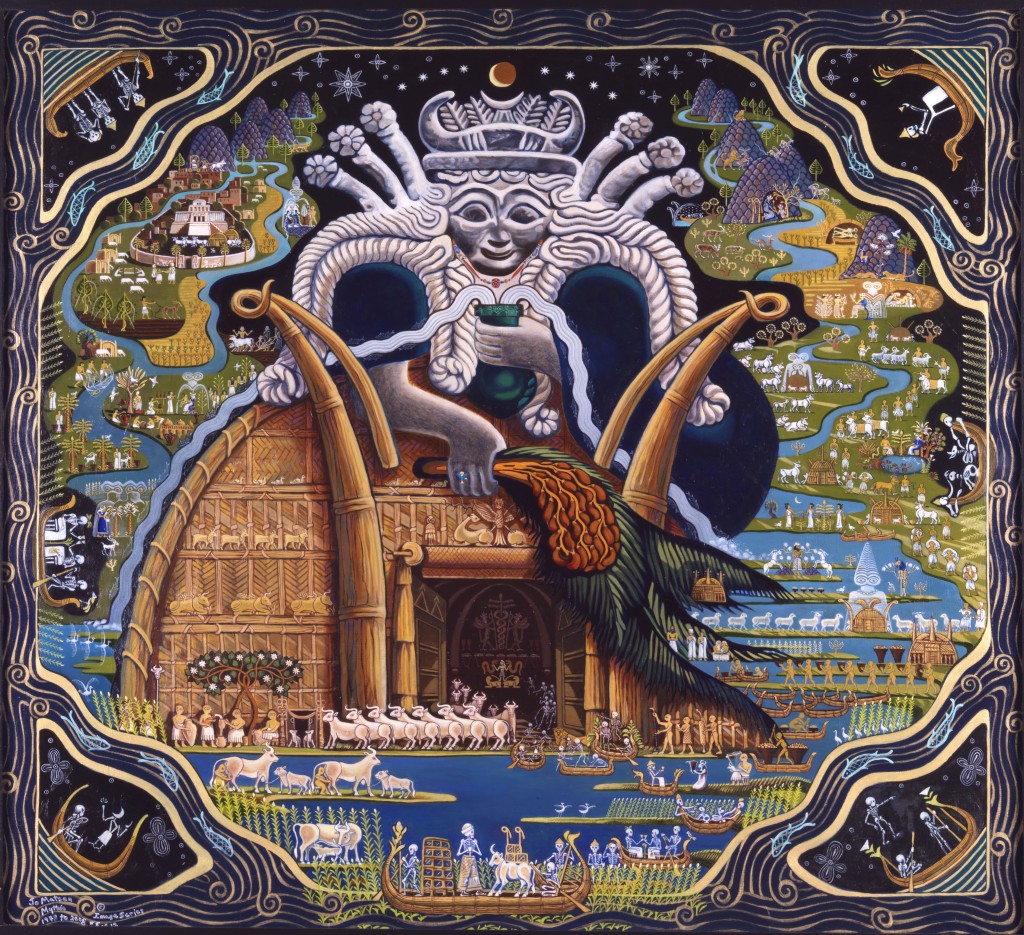 The Sumerian culture was the earliest of many in the Fertile Crescent formed by the Tigris and Euphrates Rivers in present-day Iraq. The Sumerian culture was concentrated in the region near the marshes at the mouth of the Euphrates, near where the Marsh Arabs live today. They still build reed houses like the one that forms the center of this painting. As there are no mountains at the mouth of the Euphrates, buildings found their first use as temples and mountain-substitutes. Here a giant reed house topped by a female figure is temple, mountain and cave. The doorway is framed by two giant horns made of of reeds, as shown on many seal cylinders of the period, creating a sacred space inside, equivalent to the womb of the mother/mountain. Life in the form of cattle can be seen emerging from within, as the dead, in the form of skeletons, return to her nurturing interior in their reed boats. The mother figure wears a horned headdress, echoing the horns of the cattle and of the moon. She holds a vase from which stream two rivers, echoing the Tigris and Euphrates, which can also be seen flowing on either side of her. The landscape is filled with dwellings, rituals and life of all sorts as reflected on cylinder seals. In her hand she holds date leaves and fruit, another food source fed by the rivers.
The Sumerian culture was the earliest of many in the Fertile Crescent formed by the Tigris and Euphrates Rivers in present-day Iraq. The Sumerian culture was concentrated in the region near the marshes at the mouth of the Euphrates, near where the Marsh Arabs live today. They still build reed houses like the one that forms the center of this painting. As there are no mountains at the mouth of the Euphrates, buildings found their first use as temples and mountain-substitutes. Here a giant reed house topped by a female figure is temple, mountain and cave. The doorway is framed by two giant horns made of of reeds, as shown on many seal cylinders of the period, creating a sacred space inside, equivalent to the womb of the mother/mountain. Life in the form of cattle can be seen emerging from within, as the dead, in the form of skeletons, return to her nurturing interior in their reed boats. The mother figure wears a horned headdress, echoing the horns of the cattle and of the moon. She holds a vase from which stream two rivers, echoing the Tigris and Euphrates, which can also be seen flowing on either side of her. The landscape is filled with dwellings, rituals and life of all sorts as reflected on cylinder seals. In her hand she holds date leaves and fruit, another food source fed by the rivers.
Jo Matsen: Mythic Images
The Mother in the Mountain
